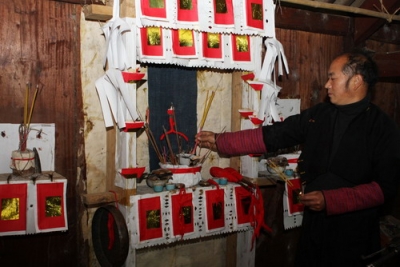H’mong (Mong) people don’t wait for New Year Eve. For them, the first coo of the cock in the 1st early morning is the landmark to start a new year.

The H’mong includes many groups: Mong Do (White Mong), Mong Lenh (Flower Mong), Mong Si (Red Mong), Mong Du (Black Mong), Mong Sua (Mong Man). Now the H’mong popularity is about 558,000 people, gather in high mountain regions of Ha Giang, Tuyen Quang, Lao Cai, Yen Bai, Lai Chau, Son La, Cao Bang, Nghe An and Thanh Hoa provinces.
H’mong people have their own calendar, according to researchers, maybe they follow the calendar of Di ethnic group (China). Based on the calendar, their New Year Holiday is estimated in later November, earlier December in Vietnamese official lunar calendar. However, nowadays, almost H’mong groups enjoy Lunar New Year of Kinh people except for a small group, such as H’mong living in Moc Chau, that still remains their own Tet as well as the national one.
In December 25th and 26th, H’mong people start resting for Tet. They cover all producing devices, for example, the lu (lũ) closing formality is hold before closing the lu ron (lũ rốn), mill is unstitched, there is a large paper to implement formality with chicken, corn cake, wine...
Formerly, H’mong people don’t make chung cake (sticky rice cake). Now chung cakes are made but it maynot be in their Tet hanquet. They consider meat, wine and corn cake three dishes which can’t be lacked in the hanquet.

In 30th evening of midnight, they worship family ghosts (ancestors) with a pig, a cock ( a virginial one is the best). After that, they kill the pig and the cock (some rich families can kill a pig for meat in 28th and 29th). The cooked meat is worshiped then they enjoy the meal with wine until hearing the first coo of the cock.
From 1st on, H’mong people wear new clothes, shoes to go out. Papao throwing is one of Tet games that they are very interested in; besides that, there are more activities such as khon (khốn) dancing, u (ụ) dancing, pipe singing, folk music singing, horses racing, cross-bow shooting..

Especially, talking about H’mong Tet, it can’t be lack of Sai San Festival, also known as Gau Tao Festival ( praying festival). If a family have weak members or find it hard to have baby, they will set up a big symbolic tree in the start of village grass. Although this festival is known to be held by a family (the family is called the symbolic host), it’s a communitial festival, sometimes a village evenly take part in the festival of other one.

Gau Tao Festival is organized to respect ancestors of harvest, cattle and to pray for babies. The festival can long 3 days if it’s held every year or 9 days if the time period is each three year. This festival is the biggest one of H’mong people in year and it best demonstrates the features of H’mong culture in Tet holidays. In this festival, after ceremony part, there are charm-transferring (giao duyên) singing and playing favourite games activities as told below.






































































































